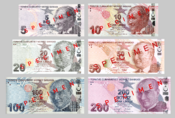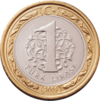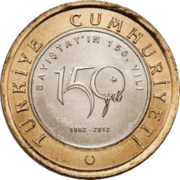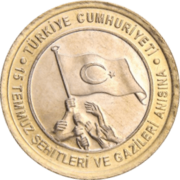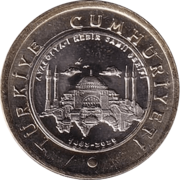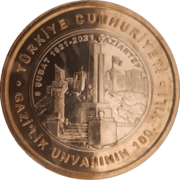Turkish lira facts for kids
Quick facts for kids Turkish lira |
|||||
|---|---|---|---|---|---|
|
|||||
| ISO 4217 Code | TRY | ||||
| User(s) | |||||
| Inflation | 75.50% | ||||
| Source | YCharts [1]. | ||||
| Method | CPI | ||||
| Subunit | |||||
| 1⁄100 | Kuruş | ||||
| Symbol | ₺ | ||||
| Kuruş | kr | ||||
| Plural | liralar | ||||
| Coins | |||||
| Freq. used | 50kr, ₺1 | ||||
| Rarely used | 1kr, 5kr, 10kr, 25kr, ₺5 | ||||
| Banknotes | |||||
| Freq. used | ₺5, ₺10, ₺20, ₺50, ₺100, ₺200 | ||||
| Printer | CBRT Banknote Printer | ||||
| The plural is rarely used (mostly as an indefinite noun) and it is never used when referring to amounts, e.g. üç lira (three lira), bin lira (one thousand lira). | |||||
The lira (Turkish: Türk lirası; sign: ₺; ISO 4217 code: TRY; abbreviation: TL) is the official currency of Turkey and Northern Cyprus, as well as one of the two currencies used in northern Syria under the country's interim government. One lira is divided into one hundred kuruş.
Contents
History
Ottoman lira (1844–1923)
The lira, along with the related currencies of Europe and the Middle East, has its roots in the ancient Roman unit of weight known as the libra which referred to the Troy pound of silver. The Roman libra adoption of the currency spread it throughout Europe and the Near East, where it continued to be used into medieval times. The Turkish lira, the French livre (until 1794), the Italian lira (until 2002), Lebanese pound and the pound unit of account in sterling (a translation of the Latin libra; the word "pound" as a unit of weight is still abbreviated as "lb.") are the modern descendants of the ancient currency.
The lira was introduced as the main unit of account in 1844, with the former currency, kuruş, remaining as a 1⁄100 subdivision. The Ottoman lira remained in circulation until the end of 1927.
First Turkish lira (1923–2005)
The banknotes of the first and second issue depict Mustafa Kemal Atatürk on the obverse side. This change was done according to the 12 January 1926 issue of the official gazette. After Atatürk's death, his portrait was replaced with one of İsmet İnönü for the third and fourth issues. Atatürk returned for the fifth issue and all subsequent issues.
After periods of the lira pegged to sterling and the franc, a peg of TL 2.8 = US$1 was adopted in 1946 and maintained until 1960, when the currency was devalued to TL 9 = US$1. From 1970, a series of hard, then soft pegs to the dollar operated as the value of the Turkish lira began to fall.
The following are based on yearly averages:
- 1960s: US$1 = TL 9
- 1970: US$1 = TL 11.30
- 1975: US$1 = TL 14.40
- 1980: US$1 = TL 80
- 1985: US$1 = TL 500
- 1990: US$1 = TL 2,500
- 1995: US$1 = TL 43,000
- 2000: US$1 = TL 620,000
- 2001: US$1 = TL 1,250,000
- 2005: US$1 = TL 1,350,000
The Guinness Book of Records ranked the Turkish lira as the world's least valuable currency in 1995 and 1996, and again from 1999 to 2004. The lira's value had fallen so far that one original gold lira coin could be sold for TL 154,400,000 before the 2005 revaluation.
Second Turkish lira (2005–present)
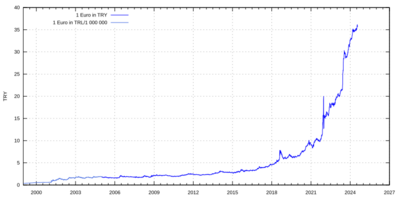
28 January 2004, the Grand National Assembly of Turkey passed a law that allowed for redenomination by the removal of six zeros from the Turkish lira, and the creation of a new currency. It was introduced on 1 January 2005, replacing the previous Turkish lira (which remained valid in circulation until the end of 2005) at a rate of YTL 1 (ISO 4217 code "TRY") = TL 1,000,000 in old lira (ISO 4217 code "TRL"). With the revaluation of the Turkish lira, the Romanian leu (also revalued in July 2005) briefly became the world's least valued currency unit. At the same time, the Government introduced two new banknotes with the denominations of ₺50 and ₺100.
In the transition period between January 2005 and December 2008, the second Turkish lira was officially called Yeni Türk lirası ("New Turkish lira"). The letter "Y" in the currency code was taken from the Turkish word yeni, meaning new. It was officially abbreviated "YTL" and subdivided into 100 new kuruş (yeni kuruş). Starting in January 2009, the "new" marking was removed from the second Turkish lira, its official name becoming just "Turkish lira" again, abbreviated "TL". All obverse sides of current banknotes have portraits of Mustafa Kemal Atatürk. The reverse sides of all coins (except for ₺1 commemorative coins) have portraits of Mustafa Kemal Atatürk. Since 2012, 9 different ₺1 circulating commemorative coins were introduced.
2018–present currency crisis
In 2018, the lira's exchange rate deteriorated rapidly, reaching ₺4.5 per US dollar by mid-May and ₺4.9 a week later. Economists generally attributed the accelerating loss of value to Recep Tayyip Erdoğan preventing the Central Bank of the Republic of Turkey from making necessary interest rate adjustments. Erdoğan, who claimed interest rates beyond his control to be "the mother and father of all evil", stated that "the central bank can't take this independence and set aside the signals given by the president." Despite Erdoğan's apparent opposition, Turkey's Central Bank raised interest rates sharply.
As of 2020, the Turkish lira continued to plummet in value, with the currency going through a process of depreciation, consistently reaching all-time lows. The Turkish lira deflated by over 400% compared to the US dollar and the euro since 2008, largely due to Erdoğan's expansionist foreign policy. Erdoğan has tried to fix the financial crisis with unorthodox banking methods.
The Turkish lira partially recovered in early 2021 with the government's increase in interest rates. However, the currency began to crash due to inflation and depreciation starting on 21 March 2021, after the sacking of Central Bank chief Naci Ağbal. The Turkish lira reached a then-all-time-low of ₺8.8 to the dollar on 4 June. The Turkish lira became one of the quickest collapsing currencies of 2021. The Turkish lira reached a new low of ₺8.9 to the dollar in September 2021. In late 2021, the Turkish lira began collapsing rapidly, with the exchange rate falling 9% against the US dollar, reaching an all-time low of ₺12.5 to the dollar. The Turkish lira continued to collapse in December, with the inflation rate reaching unseen levels, collapsing to ₺14.5 to the US Dollar, losing nearly all of its original value. On 17 December, the lira fell by 8.5%, raising the exchange rate to ₺16.5 to the US dollar. Despite the currency collapse, Erdoğan lowered interest rates down to 14% from 15%, causing the lira to lose half of its value since the start of 2021. The Turkish Lira continued to decline throughout 2022. The central bank governor Şahap Kavcıoğlu lowered interest rates by 150 basis points, from 12% to 10.5%, down from the 2021 low of 15%. The official inflation rate of the Lira through 2022 reached 83%, but independent reviews of the Turkish lira put the inflation rate even higher.
Coins
From 1 January 2009, the prefix "new" was removed from the second Turkish lira, its official name in Turkey becoming "Turkish lira" again; new coins without the word "yeni" were introduced in denominations of 1kr., 5kr., 10kr., 25kr., 50kr. and ₺1. Also, the center and ring alloys of the 50kr. and ₺1 coins were reversed.
| Current Turkish lira coins [2] | |||||||||||||
|---|---|---|---|---|---|---|---|---|---|---|---|---|---|
| Image | Value (kuruş) |
Technical parameters | Description | Date of | |||||||||
| Obverse | Reverse | Diameter (mm) |
Thickness (mm) |
Mass (g) |
Composition | Edge | Obverse | Reverse | first minting | issue | |||
| 1kr. | 16.5 | 1.35 | 2.2 | 70% Cu, 30% Zn | Plain | Value, Crescent-star, year of minting | Snowdrop | "TÜRKİYE CUMHURİYETİ", Mustafa Kemal Atatürk |
2008 | 1 January 2009 | |||
| 5kr. | 17.5 | 1.65 | 2.9 | 65% Cu, 18% Ni, 17% Zn | Tree of life | ||||||||
| 10kr. | 18.5 | 3.15 | Rumi motif | ||||||||||
 |
 |
25kr. | 20.5 | 4 | Reeded | Kufic calligraphic | |||||||
 |
 |
50kr. | 23.85 | 1.9 | 6.8 | Ring: 65% Cu, 18% Ni, 17% Zn Center: 79% Cu, 17% Zn, 4% Ni |
Large reeded | Bosphorus Bridge and Istanbul silhouette | |||||
 |
 |
₺1 | 26.15 | 8.2 | Ring: 79% Cu, 17% Zn, 4% Ni Center: 65% Cu, 18% Ni, 17% Zn |
inscribed, T.C. letters and tulip figure | Rumi motif | ||||||
 |
 |
₺5 (Commemorative) | 28.15 | 8.25 | Ring: 64% Cu, 32% Zn, 4% Ni Center: 64% Cu, 27% Ni, 9% Zn |
Large reeded | Rub el Hizb | 2023 | 29 October 2023 | ||||
| These images are to scale at 2.5 pixels per millimetre. For table standards, see the coin specification table. | |||||||||||||
Circulating commemorative coins
Since 2012, the Turkish State Mint has introduced nine commemorative coins in circulation.
-
Commemorative coin for martyrs and veterans of July 15th (2016)
-
Commemoration of Hagia Sophia's reversion to mosque (2020)
-
100th year of honoring Antep province with the ghazi title (2021)
- 2018: Commemoration of inauguration ceremony of the President Recep Tayyip Erdoğan
- 2020: 100th anniversary of Grand National Assembly of Turkey
- 2022: Commemoration of the opening ceremony of 1915 Çanakkale Bridge
- 2022: 100th anniversary of the Great Offensive
- 2023: 100th years of the republic 5 Turkish lira
Banknotes
A new series of banknotes, the "E-9 Emission Group" entered circulation on 1 January 2009, with the E-8 group ceasing to be valid after 31 December 2009 (although still redeemable at branches of the Central Bank until 31 December 2019). The E-9 banknotes refer to the currency as "Turkish lira" rather than "new Turkish lira" and include a new ₺200 denomination. The new banknotes have different sizes to prevent forgery. The main specificity of this new series is that each denomination depicts a famous Turkish personality, rather than geographical sites and architectural features of Turkey. The dominant color of the 5-Turkish-lira banknote has been determined as "purple" on the second series of the current banknotes.
| Current Turkish lira banknotes 9. Emission Group | ||||||||||||
|---|---|---|---|---|---|---|---|---|---|---|---|---|
| Image | Value (₺) |
Dimensions (mm) |
Main Colour | Description | Date of issue | |||||||
| Obverse | Reverse | Obverse | Reverse | Watermark | ||||||||
| ₺5 | 130 × 64 | Brown | Mustafa Kemal Atatürk | Aydın Sayılı: solar system, atom, left-handed Z-DNA helix. |
Mustafa Kemal Atatürk, value | 1 January 2009 | ||||||
| Purple | 8 April 2013 | |||||||||||
| ₺10 | 136 × 64 | Red | Cahit Arf: Arf invariant, arithmetic series, abacus, binary sequence |
1 January 2009 | ||||||||
| ₺20 | 142 × 68 | Green | Mimar Kemaleddin: Gazi University main building, aqueduct, circular motif and cube-globe-cylinder symbolizing architecture |
|||||||||
| ₺50 | 148 × 68 | Orange | Fatma Aliye Topuz: flower and literary figures |
|||||||||
 |
 |
₺100 | 154 × 72 | Blue | Buhurizade Itri: musical notes, instruments and Mevlevi figure |
|||||||
 |
 |
₺200 | 160 × 72 | Pink | Yunus Emre: Yunus's mausoleum, rose, pigeon and the line "Sevelim, sevilelim" (Let us love, let us be loved) |
|||||||
| These images are to scale at 0.7 pixel per millimetre. For table standards, see the banknote specification table. | ||||||||||||
Currency sign
The lira was originally symbolised as TL, inverting the characters of the Ottoman lira's sign, LT, which stood for "Livre Turque" in French. Historically English language sources used "£T" or "T£" for the currency, but it is unknown whether this notation was ever used within Turkey.
The current currency sign of Turkish lira was created by the Central Bank of the Republic of Turkey in 2012. The new sign was selected after a country-wide contest. The new symbol is composed of the letter L shaped like a half anchor, and embedded double-striped letter T angled at 20 degrees.
The design, created by Tülay Lale, was endorsed after a country-wide competition. It was chosen as the winner from a shortlist of seven submissions to the board of the Central Bank, selected from a total of 8,362 entries. The symbol resembles the first letter of the Turkish monetary unit, L, in the form of a half anchor with double stroke.
Prime Minister Recep Tayyip Erdoğan announced the new symbol on 1 March 2012. At its unveiling, Erdoğan explained the design as "the anchor shape hopes to convey that the currency is a 'safe harbour' while the upward-facing lines represent its rising prestige".
Faik Öztrak, vice chairman of the main opposition party CHP, alleged that the new sign resembles the initials TE of then-prime minister Tayyip Erdoğan in a reference to the tughra of Ottoman sultans. The new Turkish lira sign was also criticized for allegedly showing a similarity with an upside-down Armenian dram sign.
In May 2012, the Unicode Technical Committee accepted the encoding of a new character Error using : Input "20BA" is not a hexadecimal value. for the currency sign, which was included in Unicode 6.2 released in September 2012. On Microsoft Windows operating systems, when using Turkish-Q or Turkish-F keyboard layouts, it can be typed with the combination AltGr.
Current exchange rates
| Current TRY exchange rates | |
|---|---|
| From Google Finance: | AUD CAD CHF EUR GBP HKD JPY USD AZN NZD RUB |
| From Yahoo! Finance: | AUD CAD CHF EUR GBP HKD JPY USD AZN NZD RUB |
| From XE.com: | AUD CAD CHF EUR GBP HKD JPY USD AZN NZD RUB |
| From OANDA: | AUD CAD CHF EUR GBP HKD JPY USD AZN NZD RUB |
| From fxtop.com: | AUD CAD CHF EUR GBP HKD JPY USD AZN NZD RUB |
See also
 In Spanish: Lira turca para niños
In Spanish: Lira turca para niños
- Banknotes of Turkey
- Coins of Turkey
- Economy of Turkey
- Economy of Northern Cyprus
- Ottoman lira


